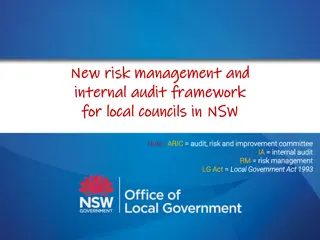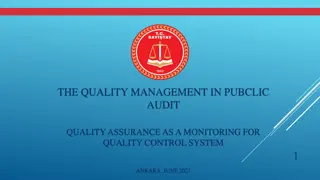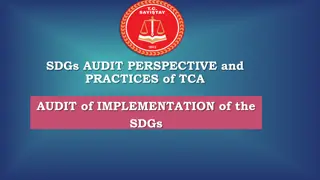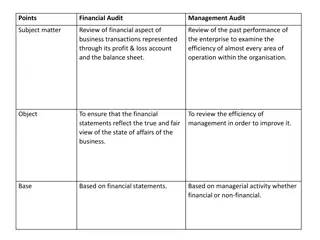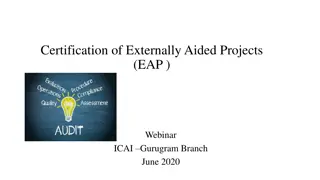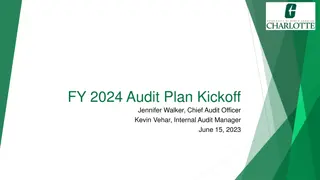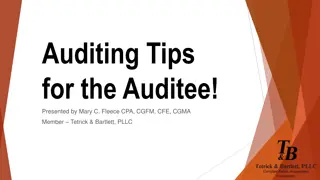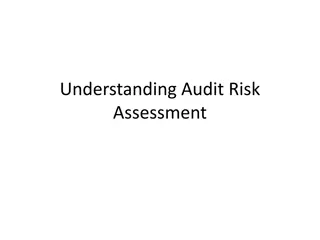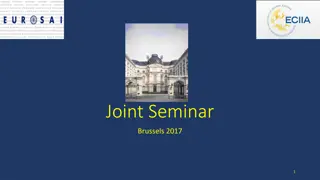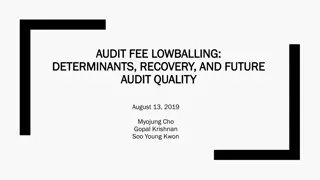Governance and Audit Practices for Externally Aided Projects in India
The implementation of Externally Aided Projects (EAPs) in India, supported by agencies like the World Bank and ADB, has evolved over the years. This involves maintaining separate project accounts, ensuring audit arrangements, and following specific methodologies for financial and compliance audits. The objective is to manage resources efficiently, maintain accountability, and ensure that projects are executed as per regulations.
Download Presentation

Please find below an Image/Link to download the presentation.
The content on the website is provided AS IS for your information and personal use only. It may not be sold, licensed, or shared on other websites without obtaining consent from the author.If you encounter any issues during the download, it is possible that the publisher has removed the file from their server.
You are allowed to download the files provided on this website for personal or commercial use, subject to the condition that they are used lawfully. All files are the property of their respective owners.
The content on the website is provided AS IS for your information and personal use only. It may not be sold, licensed, or shared on other websites without obtaining consent from the author.
E N D
Presentation Transcript
Certification of Externally Aided Projects (EAP ) Webinar ICAI Gurugram Branch June 2020
EAPs in India There are several Donor Agencies like World Bank, ADB etc which aid countries in important infrastructure projects or Social Sector Projects too Implementation of Externally Assisted Projects (EAPs) including World Bank assisted projects has undergone a considerable change during the last decade. The project implementation was traditionally through centralized and Government implementation is carried out in a more decentralized manner through Special Purpose Vehicles (SPVs) like registered Societies, NGOs etc. There is also increasing trend of donors especially World Bank in devolving funds to the Local Bodies. The Assistance can be by way of grants or soft loans to the Govt/Implementing Agency agencies . In recent times
Accounts and Audit arrangements Separate project accounts for the EAP component are mandatorily required to be maintained by the ImplementingAgency. There has to exist a Provision for audit in the Agreement. Financial covenant of the agreement envisages appointment of Independent Auditors acceptable to the Bank. With time, the CAG of India has been accepted as an independent auditor by the donor agencies for issue of audit certificates, certifying that the expenditure shown in the Statement of Expenditure (SoE) is correct and utilized for the purpose of project. Independence of the CAG is ensured through provisions of the Constitution of India and CAG s (DPC),Act, 1971. The Foreign aid by way of grants/loan is routed though the Government accounts and the implementing agency should be a Government Department, for the audit by the C&AG. If the entity is not under the sole audit jurisdiction of CAG, audit could be done by entrusting the same to the CAG under Section 19/20 of the CAG s (DPC)Act, 1971
Audit Methodology Annual audit of EAP during normal audit of DDO/Project Implementing Authority. Integrated Audit Financial and Compliance. Central and Local Audit. Local Audit: Areas usually seen Award Of Contracts. Execution of Contracts and Expenditure booked for the period Project management systems and Accountability issues Investment decisions of surplus funds if any . Internal controls and risk management
Audit Objectives and Scope Overall objective for an audit of a government-executed project is to obtain reasonable assurance that resources are being managed in accordance with the financial regulations applicable. To ensure that required systems for implementation, monitoring and evaluation exist. To ensure that the required accounting and financial reporting procedures exist. Project disbursement is made in accordance with the project document. Project disbursements are validly supported by adequate documentation. Project financial reports are fairly and accurately presented. An appropriate management structure, internal controls and record-keeping systems are maintained by the project management and can be relied upon. Project monitoring and evaluation are undertaken and reports are prepared as required.
What does the SAI Audit cover ? Reporting: Issuing Audit Certificate and Audit Report (ML): Whether the implementing agencies carried out expenditure as per pattern/conditions/requirements spelt out in the Project Appraisal Document: Loan Agreement becomes the core document. Identify inadequacies in systems and control. Cases of presumptive fraud if any . Wasteful expenditure. Expenditure incurred is strictly according to the terms and conditions of the Assistance and for the Project objectives
Audit Certificate (AC) AC is to be issued on Project Financial Statements accompanied by management's assertion for fair presentation of the PFS Allowing expenditure. A separate certificate should be issued for each project indicating the amount held under objection in relation to any wanting vouchers, D.C. bills, sanctions etc. and mis-classifications, defalcation, overpayments etc. that may have come to notice of the audit Irregularities noticed during central audit as well as local audit should be distinctly recorded and separate file for certification in respect of each project maintained. Management Letter pointing out issues other than financial statements like weaknesses in internal control or value for money issues.
Time Schedule of Certification As prescribed in the Agreement. The audit certificates are required to be issued within 6 months from the closure of Accounts, i.e. accounts are required to be certified latest by 30th September every year. Implementing agencies are required to furnish PFS to Audit by 1st May and remaining five months are available for Central and Local Audit. We certify the project accounts throughout the year (for arrear period as also for the current year) depending upon the production of PFS and other documents usually delays are observed.
Issue of AC and Impact of the AC Issued to the Implementing Agencies/Entities audited. Not directly issued to the Donor. Implementing Agency submits the reimbursement claim to CAAA, MoF along with the Audit Certificate. CAAA processes the claim and forwards the same to Donor for reimbursement. Reimbursed amount is credited to the Government Account maintained by the MoF. Only the amount certified is reimbursed. Amount objected by audit is withheld till removal of objections. Audit Certificate should be issued in the proper printed letter head and signed by an officer not below the rank of Deputy Accountant General/Deputy Director.
List of Some Assisted Projects Roads & Highway Improvement Projects in Karnataka, Jharkhand, NE States Urban Sector Development Programmes in Rajasthan, Uttrakhand Emergency Assistance Projects- State Disaster Mgt Authority Infrastructure Dev. Programmes in Tourism Sector in NE States, Sikkim, HP. Punjab, Uttrakhand Climate Adaptation Projects Skill Development Please see Website of Department of Economic Affairs MoF for further Projects





